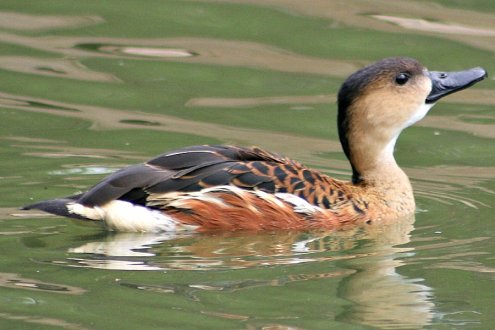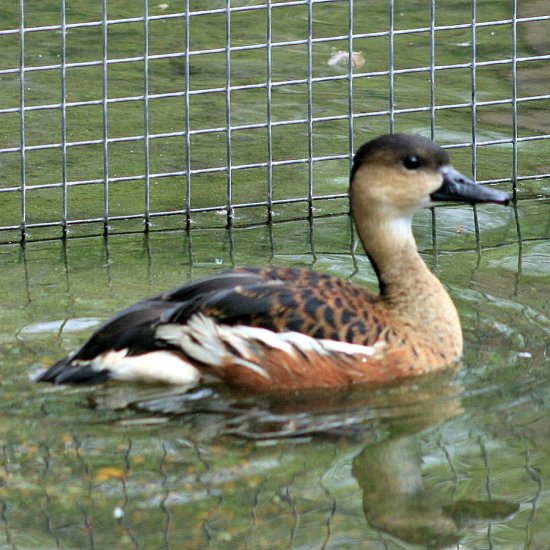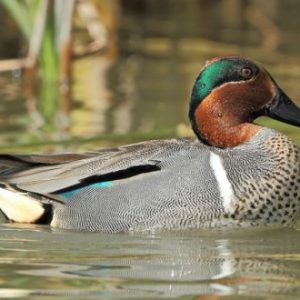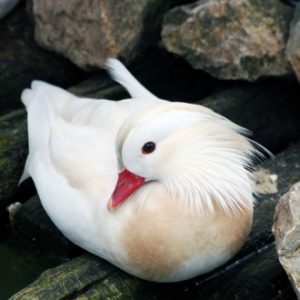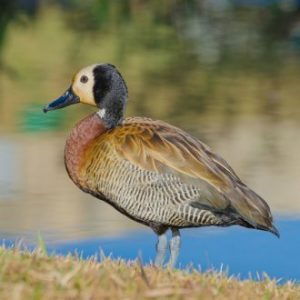Other Name: Wandering Whistling Tree Duck
Wandering Whistling Ducks are sturdy and strong-looking waterfowl, and seem like a cross between a goose and duck. They have a tall stature as well as a long neck and long legs, giving them a very upright appearance. And they do make very loud whistling calls.
Wandering Whistling Ducks are attractively colored in shades of chestnut and amber. Males and females are very similar. They have large dark eyes set off prettily in a light wheaten or buff-colored face. They have black bills and feet and a dark stripe over the top of the head that extends down the backside of the neck. The front side of the neck and the breast are dramatically speckled, and feathers on their sides form an attractive white wave-like pattern.
Range: In the wild, Wandering Whistling Ducks can be found in the Southern Pacific Ocean regions. They are mainly inhabitants of North-Eastern or tropical Australia, as well as various Pacific Islands including the Philippines and the Indonesian countries.
Habitat: Wandering Whistling Ducks are also sometimes called Tree Ducks, however, they rarely inhabit trees and prefer to spend most of their in water. These birds usually seek out deep water such as lagoons or lakes, where the aquatic vegetation that makes up the bulk of their diet is plentiful. Wandering Whistling Ducks rarely leave the vicinity of the shore and swim and dive very well.
Status in the Wild: Wandering Whistling Ducks hold a healthy wild population and are currently classified as being of Least Concern.
Status in Aviculture: Wandering Whistling Ducks are hard to find and quite rare in waterfowl collections in North America.
Breeding: Breeding occurs in the spring, and in the wild, is heralded by the rainy season. Depending on your climate, breeding may occur anywhere between December and May in the northern hemisphere. Some breeders have used overhead sprinklers to simulate a rainy season to help instigate the start of the breeding season. Typically, 6-15 eggs are laid in a nest near the water, in heavy grass. Nest boxes are also sometimes used. Wandering Whistling Ducks usually are successful parents. Do note that Whistling-duck species, as well as some other species of duck, can hybridize with one another and so pairs should be kept in separate enclosures during breeding.
Lifespan: The lifespan of ducks in captivity far exceed that of ducks in the wild. Wandering Whistling Ducks have been known to live beyond 15 years of age.
Size: Wandering Whistling Ducks weigh about 1.5 to 2 pounds. They measure 21 to 23 inches in length.
Housing Requirements: Wandering Whistling Ducks are from warm environments, and they are one of the least hardy of wild duck species. Winter shelter will be needed when keeping these birds in most areas of the United States, as they are prone to frostbite. These birds also need a significant water source to thrive. An enclosure with a three-foot-deep pond and plenty of vegetation would be ideal. Grass and soft bedding are important in raising this species. In general, Wandering Whistling Ducks do well in captivity.
Diet: The wild diet of the Wandering Whistling Duck consists mainly of aquatic and waterside plant matter, although they do also dine on insects and aquatic invertebrates. A commercial waterfowl grain-based diet is appropriate in captivity.
Miscellaneous Notes: Dendrocygna is a subfamily of waterfowl species, all of which whistle. Although they are referred to as ducks, they are not truly ducks, and trying to group Whistling Ducks under one of the larger groups of waterfowl has been a continued source for arguing among ornithologists. There are eight species of Whistling Ducks throughout the world.

